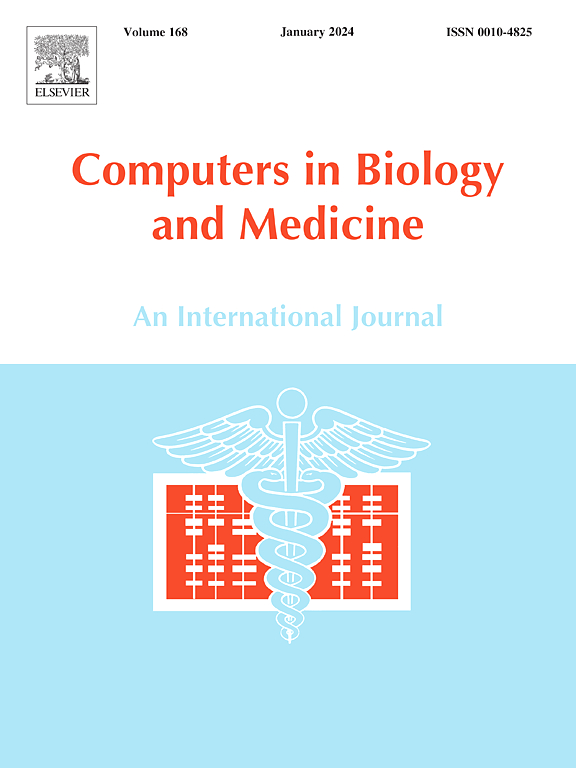Parametric model of the human pinna based on Bézier curves and concave deformations
IF 6.3
2区 医学
Q1 BIOLOGY
引用次数: 0
Abstract
A parametric representation of the complex biological structure of the human pinna is of considerable interest in applications such as the design of ear prostheses, personalization of spatial hearing, and biometric identification. Here, we describe BezierPPM, a parametric pinna model with parameters closely linked to human ear structures. BezierPPM represents the ear geometry as cubic Beziér curves and includes local modifiers of predefined concave areas. We evaluated BezierPPM by manually registering its parameters to 20 ears selected from various databases of digitized ears. The root-mean-square error between the registered and target geometries was on average 1.5 ± 0.2 mm, and the 2-mm and 1-mm completeness was 87 ± 4% and 66 ± 5%, respectively. This indicates that BezierPPM was capable of representing human pinnae very well. An in-depth analysis showed that most of the inaccuracies were located on the back side of the ear, an area having a rather low relevance for most target applications. To address potential future applications in machine-learning settings, we used BezierPPM to create a database of synthetic pinna geometries and trained a toy-example neural network to estimate BezierPPM parameters from multi-view images of this database. The estimated parameters resulted in estimated pinna geometries with a mean error of 0.3 mm, indicating that BezierPPM can accurately describe a wide variety of human pinnae, also in machine-learning settings. In summary, our evaluations demonstrate a high potential of BezierPPM for applications requiring a good representation of the relevant parts of pinna geometry, especially when targeting applications in machine-learning settings.
基于bsamizier曲线和凹形变形的人体耳廓参数化模型
人类耳廓复杂生物结构的参数化表示在耳假体设计、空间听力个性化和生物识别等应用中具有重要意义。在这里,我们描述了BezierPPM,一个参数化耳廓模型,其参数与人耳结构密切相关。BezierPPM将耳朵的几何形状表示为三次bezisamir曲线,并包含预定义凹区域的局部修饰符。我们通过手动将其参数注册到从各种数字化耳朵数据库中选择的20个耳朵来评估BezierPPM。配准几何形状与目标几何形状的均方根误差平均为1.5±0.2 mm, 2-mm和1-mm的完整性分别为87±4%和66±5%。这表明BezierPPM能够很好地代表人类的耳鸣。深入分析表明,大多数不准确的位置位于耳后侧,这一区域与大多数目标应用的相关性相当低。为了解决机器学习环境中潜在的未来应用,我们使用BezierPPM创建了一个合成耳廓几何形状的数据库,并训练了一个玩具示例神经网络,以从该数据库的多视图图像中估计BezierPPM参数。估计的参数导致估计的耳廓几何形状,平均误差为0.3 mm,这表明BezierPPM可以准确地描述各种各样的人类耳廓,也可以在机器学习设置中描述。总之,我们的评估表明,对于需要很好地表示耳廓几何相关部分的应用,特别是针对机器学习设置中的应用,BezierPPM具有很高的潜力。
本文章由计算机程序翻译,如有差异,请以英文原文为准。
求助全文
约1分钟内获得全文
求助全文
来源期刊

Computers in biology and medicine
工程技术-工程:生物医学
CiteScore
11.70
自引率
10.40%
发文量
1086
审稿时长
74 days
期刊介绍:
Computers in Biology and Medicine is an international forum for sharing groundbreaking advancements in the use of computers in bioscience and medicine. This journal serves as a medium for communicating essential research, instruction, ideas, and information regarding the rapidly evolving field of computer applications in these domains. By encouraging the exchange of knowledge, we aim to facilitate progress and innovation in the utilization of computers in biology and medicine.
 求助内容:
求助内容: 应助结果提醒方式:
应助结果提醒方式:


